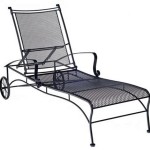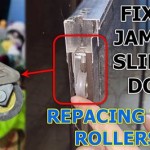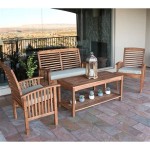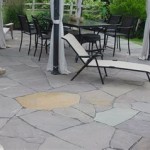How To Secure a Patio Umbrella Effectively
Patio umbrellas provide essential shade and comfort, transforming outdoor spaces into havens of relaxation. However, their large surface area makes them susceptible to wind, posing a potential safety hazard if not adequately secured. While umbrella bases are the conventional solution, circumstances may necessitate alternative methods. This article explores various strategies to secure a patio umbrella effectively without relying solely on a traditional base.
Securing a patio umbrella without a base requires careful consideration of factors such as the umbrella's size, the wind conditions in the area, and the surrounding environment. The goal is to provide sufficient stability to prevent the umbrella from tipping over, being carried away by the wind, or causing damage to property or injury to individuals. Understanding the principles of leverage and wind resistance is crucial in implementing effective securing techniques.
Utilizing Weights and Ballast
One of the most common and readily available methods for securing a patio umbrella involves using alternative weights and ballast. This approach aims to increase the overall mass at the base of the umbrella pole, thereby enhancing its resistance to tipping. Several options can be employed, ranging from readily available household items to purpose-built solutions.
Sandbags are a versatile and effective choice. They are relatively inexpensive, easy to fill, and can be strategically positioned around the base of the umbrella pole to provide substantial weight. The number and size of sandbags required will depend on the size of the umbrella and the typical wind conditions. Heavier sandbags, typically weighing between 25 and 50 pounds, are recommended for larger umbrellas or areas prone to strong winds. Placing the sandbags as close to the pole as possible maximizes their effectiveness by reducing the leverage exerted by the wind on the umbrella canopy.
Concrete blocks offer another durable and stable weighting option. Similar to sandbags, they can be arranged around the base of the umbrella pole to increase its weight and stability. Concrete blocks are heavier and more resistant to shifting than sandbags, making them suitable for areas with very high winds. However, their rigid nature also means they may pose a tripping hazard if not carefully positioned and marked. Consider using brightly colored paint or reflective tape to increase their visibility, especially in low-light conditions.
Water-filled containers, such as large plastic bottles or specially designed water bladders, present a convenient alternative, particularly when portability is a concern. These containers can be easily emptied and refilled as needed, making them ideal for situations where the umbrella needs to be moved frequently. When selecting water-filled containers, ensure they are made of durable, weather-resistant materials to prevent leaks or damage from prolonged exposure to sunlight. Fill them completely to maximize their weight and stability.
Pavers or bricks are aesthetically pleasing options that can blend seamlessly with the surrounding patio or garden. They can be arranged in a decorative pattern around the base of the umbrella pole, adding both weight and visual appeal. Choose pavers or bricks that are sufficiently heavy and large to provide adequate stability. Consider using a circular arrangement to distribute the weight evenly around the pole. Ensure the pavers or bricks are securely interlocked to prevent them from shifting or being dislodged by the wind.
Regardless of the specific weighting method chosen, it is essential to distribute the weight evenly around the base of the umbrella pole. Uneven weight distribution can create instability and increase the risk of tipping. Regularly inspect the weights to ensure they remain securely in place and are not damaged by weather or wear and tear. Adjust the amount of weight as needed based on the changing wind conditions.
Anchoring the Umbrella to Existing Structures
Another effective strategy for securing a patio umbrella involves anchoring it to existing structures such as fences, railings, or walls. This approach utilizes the stability of these structures to provide additional support and prevent the umbrella from tipping or being carried away by the wind. The specific anchoring method will depend on the type of structure available and the design of the umbrella.
If a sturdy fence or railing is nearby, it can be used as a secure anchor point for the umbrella pole. Heavy-duty clamps or brackets can be used to attach the umbrella pole to the fence or railing. Ensure the clamps or brackets are made of durable, weather-resistant materials such as galvanized steel or stainless steel. Position the clamps or brackets as low as possible on the pole to maximize their effectiveness in preventing tipping. Regularly inspect the clamps or brackets to ensure they remain securely fastened and are not showing signs of wear or corrosion. Tighten them as needed to maintain a firm grip on the umbrella pole.
Eye bolts and ropes offer a simple and versatile anchoring solution. Eye bolts can be securely fastened to a nearby wall or sturdy post. Ropes can then be attached to the eye bolts and used to tie down the umbrella pole. Use strong, weather-resistant ropes such as nylon or polyester. Ensure the ropes are tightly secured to both the eye bolts and the umbrella pole. Consider using multiple ropes to provide additional stability and prevent the umbrella from swaying excessively in the wind. Regularly inspect the ropes for signs of fraying or wear and replace them as needed.
Permanent mounting brackets provide a more secure and long-lasting anchoring solution. These brackets are typically bolted directly to a wall or patio floor, providing a solid base for the umbrella pole. Choose mounting brackets that are specifically designed for outdoor use and are made of durable, weather-resistant materials. Ensure the brackets are securely fastened to the wall or floor using appropriate hardware. Follow the manufacturer's instructions carefully when installing the brackets. Consider the location of the brackets carefully to ensure they provide adequate support for the umbrella and do not create a tripping hazard.
When anchoring an umbrella to an existing structure, it is crucial to consider the structural integrity of the structure itself. Ensure the fence, railing, or wall is strong enough to withstand the forces exerted by the wind on the umbrella. Avoid anchoring the umbrella to weak or unstable structures, as this could lead to damage or collapse. Always prioritize safety and consult with a professional if you are unsure about the suitability of a particular structure for anchoring purposes.
Ground Anchors and Tethers
For umbrellas positioned on soft ground, such as lawns or gardens, ground anchors and tethers offer an alternative to traditional bases. These systems provide a secure connection between the umbrella and the ground, preventing it from tipping or being blown away. Various types of ground anchors are available, each designed for different soil conditions and umbrella sizes.
Spiral ground anchors are a popular choice for securing umbrellas in soft soil. These anchors are typically made of galvanized steel and feature a spiral design that allows them to be easily screwed into the ground. To install a spiral ground anchor, simply screw it into the ground at an angle near the base of the umbrella pole. Attach a tether or rope to the anchor and secure it to the umbrella pole. The spiral design provides a strong grip in the soil, preventing the anchor from being pulled out by the wind.
Stake-style ground anchors are another option for securing umbrellas in soft ground. These anchors consist of a series of stakes that are driven into the ground around the base of the umbrella pole. Connect the stakes with ropes or straps to create a secure perimeter around the umbrella. Stake-style ground anchors are particularly effective in sandy or loose soil where spiral anchors may struggle to gain purchase. Ensure the stakes are driven deep enough into the ground to provide adequate stability.
Auger-style ground anchors offer a more heavy-duty solution for securing umbrellas in challenging soil conditions. These anchors feature a large auger that is screwed into the ground using a wrench or other tool. Auger-style anchors provide exceptional holding power and are ideal for securing large umbrellas in areas with strong winds. They are more difficult to install than spiral or stake-style anchors but offer superior stability.
Regardless of the type of ground anchor chosen, it is essential to select an anchor that is appropriately sized for the umbrella and the soil conditions. A smaller anchor may not provide sufficient holding power, while a larger anchor may be unnecessary and difficult to install. Always follow the manufacturer's instructions when installing ground anchors. Regularly inspect the anchors and tethers to ensure they remain securely in place and are not showing signs of wear or damage. Tighten the tethers as needed to maintain a firm connection between the umbrella and the ground.
In addition to the anchoring method, choosing the right type of umbrella can also contribute to its stability. Umbrellas designed with wind vents allow air to pass through the canopy, reducing the overall wind resistance and minimizing the risk of tipping. Consider investing in an umbrella with wind vents if you live in an area prone to strong winds. Regularly lowering or closing the umbrella during periods of high wind is also a prudent measure to prevent damage and ensure safety.

7 Ways To Keep Your Patio Umbrella From Falling Over Sunnydaze Decor

Make Your Own Umbrella Stand Side Table

How To Attach A Patio Umbrella Your Fence In Minutes Exquisitely Unremarkable

Umbrella Base Options How To Safely Secure Your

Make Your Own Umbrella Stand Side Table

Diy Patio Umbrella Stand I Give No Sips

How To Stop Your Umbrella From Blowing Away This Summer Today S Patio

9 Tips On How To Keep Your Patio Umbrella From Spinning

Umbrella Base Options How To Safely Secure Your

The 3 Best Patio Umbrellas And Stands Of 2024 Reviews By Wirecutter
Related Posts








